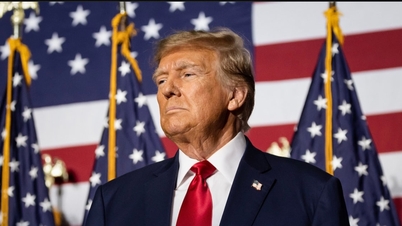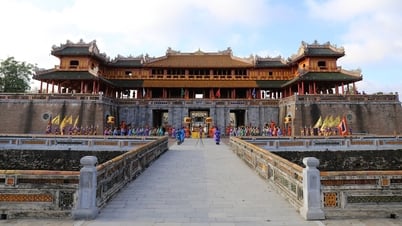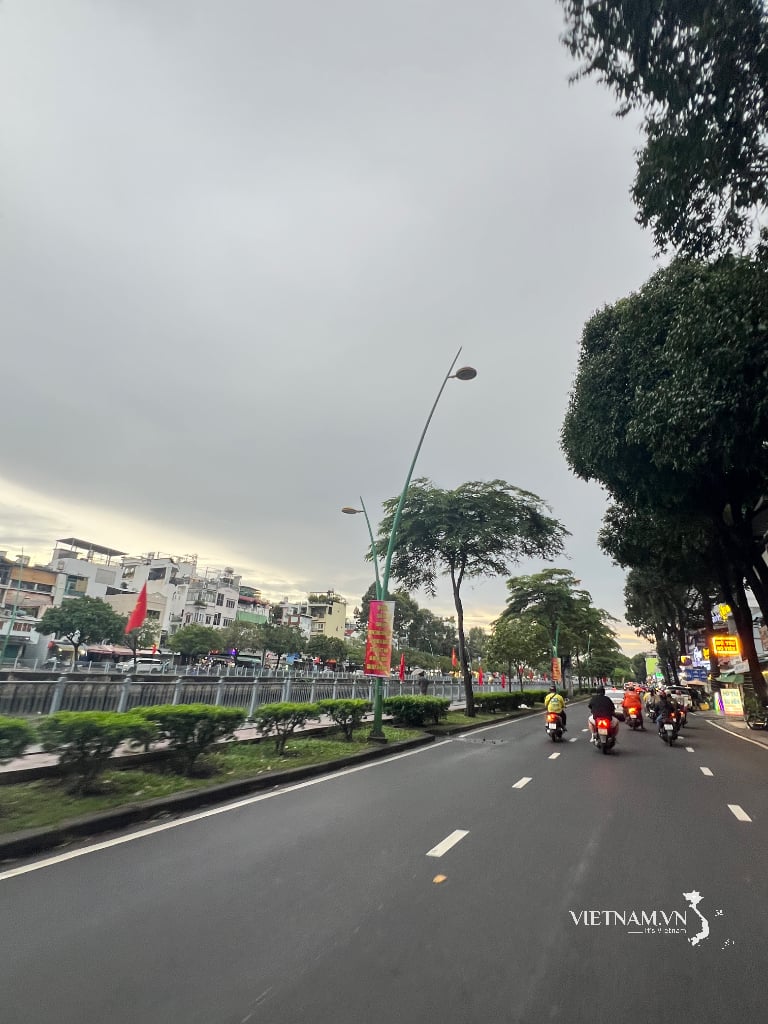The A Sào historical site - echoing the oath made by the Hóa River.

A Sào – a historical site located in An Thái commune (Quỳnh Phụ district, Thái Bình province ) – is a special place. Situated along the Hoá River, bordering Hải Phòng and Hải Dương provinces, it is blessed with the auspicious energy of the river and sea, and boasts a strategically important location. It was once the estate of Phụng Càn Vương Trần Liễu, the father of Hưng Đạo Đại Vương Trần Quốc Tuấn, whom the Vietnamese commonly refer to as Đức Thánh Trần – a concise yet highly respected title.
This place is also identified as a military supply depot serving the two resistance wars against the Mongol invaders (1285, 1288) of the Tran Dynasty, directly related to Tran Hung Dao. The folk verse: " No matter who the ruler is, when passing through A Sao Temple, one must dismount from their horse " shows the solemnity and sacredness of the temple as well as this land.
According to legend, at the age of 18, Tran Quoc Tuan was granted the title of High Marquis and assigned by the Imperial Court to govern the A Sao region.
According to the elders here, A Sào means "the nest, the lair" of the Trần dynasty. "A" stands for Đông A – literally meaning "the Trần family," while "Sào" means nest or lair. When the Trần dynasty achieved consecutive victories in the three wars against the Mongol invaders, the fighting spirit of the Trần army and people became increasingly fervent and was known as the Đông A spirit.
Journalist La Quy Hung, who has conducted extensive research on the Tran Dynasty in Thai Binh, believes that Tran Quoc Tuan was entrusted by the court with the important task of building up military forces and establishing a system of warehouses to store military supplies. People throughout the region flocked to the area, bringing rice and grain, hoping to contribute their efforts and resources to the court's fight against the enemy.
The warehouses in Me Thuong were overflowing, and many more had to be built. "A well-fed army is a strong army," and the system of food and weapons warehouses in A Sao became a solid rear base, along with Long Hung (Hung Ha), creating a huge logistical potential for the Tran dynasty's army to resist and defeat the Yuan-Mongol invaders.
After more than 700 years, this place still bears the traces of granaries associated with the surrounding villages (in Quynh Phu district), such as Me Thuong village (rice granary), A Me (rice storage place of the Tran dynasty), Dai Nam (large grain granary), Am Qua village (sword granary), Go Dong Yen (horse saddle making place)...
A Sào also has the Elephant Wharf, associated with the story of an elephant getting stuck in the mud while carrying Tran Hung Dao and his army across the Hoa River to Luc Dau Giang for a decisive battle against the Mongol army led by O Ma Nhi during the third resistance war against the invaders in 1288.
When the war elephants got stuck in the mud, the people brought wood, bamboo, straw, and even dismantled their houses made of ironwood and rafts to try to rescue them, but they couldn't pull them out. Meanwhile, the situation was too urgent, so General Tran Quoc Tuan had no choice but to swallow his tears and board a boat to cross the river to fight the enemy.
The war elephant, with tears in its eyes, looked at its commander, let out a long, mournful roar, and slowly sank into the alluvial soil. Grieving for the loyal war elephant, Hung Dao Dai Vuong drew his sword, pointed it at the river, and swore: "This time, in this war against the Yuan invaders, if I do not win, I will not return to this land."
General Hung Dao and the people of the Tran dynasty fulfilled their oath of life and death, defeating the fierce Mongol invaders and protecting the beautiful land of Dai Viet. General Hung Dao ordered the construction of an elephant's tomb at the riverbank, and the people erected a shrine to worship it. From then on, the riverbank was known as Elephant Wharf or Elephant Wharf. Later, the people of A Sao carved a stone elephant statue to worship at the riverbank.
Ben Tuong is a place of worship for the war elephants of Tran Hung Dao.

One of the questions concerning the Tran Dynasty in general and Tran Hung Dao in particular that historians are still seeking to answer is where Hung Dao Dai Vuong Tran Quoc Tuan was born.
The military genius and outstanding cultural figure Tran Quoc Tuan, along with the Tran dynasty's army, successfully repelled and defeated the fierce Mongol cavalry, safeguarding the nation's borders and contributing a shining example of unwavering loyalty to the country and filial piety to the nation.
Historians believe that Tran Hung Dao was born sometime between 1226 and 1231. His hometown was also the ancestral home of the Tran dynasty, which began with Tran Canh, also known as Tran Thai Tong, the younger brother of Tran Lieu - Tran Hung Dao's father.
According to the book "Dong A Liet Thanh Tieu Luc," Saint Father Tran Lieu - the father of Tran Hung Dao - was the eldest son of Emperor Tran Thua, the grandson of Tran Ly, the great-grandson of Tran Hap, and the great-great-grandson of Tran Kinh. Later, this Tran family followed the banks of the Nhi River downstream, engaging in fishing. By the time of Tran Kinh, they were fishermen in the Tuc Mac River area ( Nam Dinh ).
Tran Hap migrated to the river region of Ngu Thien (Thai Binh) to fish, then switched to farming. During the reign of Tran Ly, he achieved prominence in Luu Xa (Hung Ha, Thai Binh). According to official historical sources, for about a century, spanning four generations before Tran Quoc Tuan, from his great-grandfather Tran Hap, his great-grandfather Tran Ly, his grandfather Tran Thua, to his father Tran Lieu, all lived and established themselves in Luu Xa, Long Hung prefecture, now part of Hung Ha (Thai Binh).
But those places are only his birthplace; where was Hung Dao Dai Vuong born? We need to find out about his father, Tran Lieu. When his wife, Princess Thuan Thien, was brought into the palace and made Empress in 1237, Tran Lieu gathered troops at the Cai River and rebelled. To resolve this trouble, King Tran Thai Tong gave land in Yen Phu, Yen Duong, Yen Sinh (Dong Trieu, Quang Ninh), and An Bang in Yen Hung (Quang Ninh) to Tran Lieu to establish a settlement.
Tran Lieu was also granted an estate in A Sao, located next to the Hoa River. It can be seen that a series of estates granted to the Tran dynasty's princes in this area appeared simultaneously with or after the Tuc Mac region was built to become the second capital of the Tran dynasty from 1239 to 1262.
While official historical records suggest that Tran Lieu's estates, including A Sao, were established after Tran Quoc Tuan's birth (as mentioned above, official records indicate his birth year as between 1226 and 1231) and there are no documents recording his birthplace, many elderly members of the Tran family living near A Sao believe that Hung Dao Dai Vuong was born there.
Mr. Tran Duy Khang, the caretaker of A Sao Temple, said that A Sao is not only associated with Tran Hung Dao's childhood but also with the career of this outstanding military leader of the Tran Dynasty.
In conversation with us, Mr. Khang recounted that, according to what he learned from the elders in his family, when Tran Lieu's wife (whose given name was Mrs. Nguyet) chose to settle in A Sao, she was very diligent in offering incense and worshiping, showing reverence to the Three Jewels above, filial piety to her ancestors below, helping orphans and widows, and assisting the poor and needy. Tran Lieu's virtue was high, and his wife's heart was pure, reaching even the highest heavens.
She gave birth to an exceptionally handsome baby boy. One hundred days later, Tran Lieu brought her son to the capital so that her brother, King Tran Thai Tong, could name him. Seeing the child's handsome features, broad chin, large mouth, and clear eyes, the King named him Tran Quoc Tuan, meaning a handsome son of the Tran family of Vietnam.
After completing his three-year confinement period, Tran Quoc Tuan went to the capital to be adopted by Princess Thuy Ba, the elder sister of King Tran Thai Tong. Princess Thuy Ba summoned learned scholars to educate and train Tran Quoc Tuan. By the age of 18, Tran Quoc Tuan possessed exceptional skills in military strategy and literary arts.
Following their first victory against the Mongol invaders in 1258, the Tran dynasty determined that the enemy would launch another invasion, so they had to establish a place to stockpile food and weapons and train soldiers in preparation for the upcoming battles. Tran Quoc Tuan was then granted the title of High Marquis and assigned by the court to govern A Sao.


According to historian Le Van Lan, A Sao was a familiar area for Tran Hung Dao. It was closely associated with his leadership of the Battle of Bach Dang. A Sao served two functions: firstly, as a granary throughout all periods of the Tran Dynasty's resistance, and secondly, as it lay on Tran Hung Dao's route to the Battle of Bach Dang, and even to the A Lo fort left behind by the Yuan-Mongol army during their second invasion in 1285.
According to the strategic division of responsibilities at the Battle of Bạch Đằng, the Trần Dynasty kings were stationed upstream (now Chí Linh), while the downstream area near the sea was under the command of Trần Hưng Đạo.
The Battle of Bạch Đằng was also commanded by Trần Thánh Tông and Trần Nhân Tông. When Ô Mã Nhi was captured on the Bạch Đằng River, General Đỗ Hành led the prisoner upstream but handed him over to the wrong place. Đỗ Hành traveled upstream from the lower reaches of the Bạch Đằng River to the area where the two Trần kings were commanding. Instead of handing Ô Mã Nhi over to his father, Trần Thánh Tông, Đỗ Hành handed the enemy general over to Trần Nhân Tông. Therefore, there is a story that after the Battle of Bạch Đằng, Đỗ Hành was not promoted.
On the 30th day of the 2nd lunar month of the year Mau Thin (1288), the start of the Bach Dang campaign, the Mongol-Yuan infantry returned to their country via mountain routes, while the navy followed the river. At this time, the Tran dynasty closely monitored the situation and decided to attack the naval forces rather than the infantry commanded by Thoat Hoan.
The Trần dynasty king commanded the interceptions, sniping attacks, and especially the disruption of the parallel escort formations of the Yuan-Mongol army. Our army destroyed the Đông Triều bridge, preventing the enemy infantry and cavalry from pursuing Ô Mã Nhi's naval forces.
Tran Hung Dao, positioned downstream, was tasked with calculating the timing and routes that the enemy navy would take after the battle at Dong Trieu, from Da Bac, Bach Dang, and the Gia River. To reach those areas, Tran Hung Dao had to pass through A Sao, which at that time served as a strategic logistics and reserve depot.
Historian Le Van Lan asserts that A Sao was a strategic logistical and reserve location, similar to Tran Thuong (Ha Nam). The Tran dynasty was clever in establishing logistical depots in all strategic locations in case they were needed, rather than setting up the A Sao granary in just one year, one month, or one day.

Painting depicting Tran Hung Dao and the victory at Bach Dang.

Professor Le Van Lan believes that Tran Hung Dao's return to Van Kiep has reached a global, universal, and historical level.
In 1289, one year after the Battle of Bạch Đằng, Trần Hưng Đạo was bestowed the title of Great King. He left Thăng Long, distancing himself from politics, glory, wealth, and fame—which were certainly illusory—and the complexities of the post-war period…
“ Leaving Thang Long, Tran Hung Dao had numerous places to go, such as ‘Sinh Kiet Bac, Thac Tran Thuong, Huong Bao Loc,’ but he chose to return to Van Kiet, where he fought his second major battle. Tran Hung Dao knew that at Luc Dau Giang, no matter who the enemy was, coming from the North, they would have to pass through there. He considered his presence there as that of an old soldier voluntarily guarding a strategic location that the enemy had to pass through every time they entered or left ,” historian Le Van Lan said.
Tran Hung Dao's dual objective created something great: he renounced the riches and dangers of the post-war era, but not absolutely, completely. Instead, he voluntarily became an old soldier, returning to Van Kiep to guard the country.
“ Besides its strategic military location, Van Kiet also has spiritual significance. The area is surrounded by two mountains, Nam Tao and Bac Dau, symbols of the heavenly realm. I went to the Kiet Bac temple grounds, excavated archaeologically, and removed a layer of soil about 1 meter deep. Beneath it was a courtyard paved with raised red chrysanthemum-patterned tiles. Every time the sunlight shone on it, it was very dazzling and magnificent, ” Professor Le Van Lan remarked.
Van Kiet possesses a geographical location, natural landscape, and especially top-tier spiritual value on a small scale, while on a larger scale, it serves as a strategic location guarding the entire Luc Dau Giang intersection.
Tran Hung Dao's choice of Van Kiep reflects his insight as a geomancer, a sorcerer, an eye capable of seeing the universe. Tran Hung Dao lived in Van Kiep for 11 years. He also dispatched his subordinates and servants to assist the court, such as Tran Thi Kien, Truong Han Sieu, and Pham Ngu Lao…
In August 1300, Tran Hung Dao was dying. King Tran Anh Tong traveled by boat from Thang Long, passing through Dong Bo Dau wharf, entering the Duong River estuary to Luc Dau Giang, and climbing to Phu De (Kiep Bac Temple). The King asked: " If, unfortunately, I die, and the invaders from the North attack again, what will we do? "
Hung Dao replied: “ …the enemy relies on long battles, we rely on short-lived troops… In peacetime, easing the people's burdens to lay deep roots and ensure lasting stability is the best strategy for preserving the country .”

Source





































































































Comment (0)